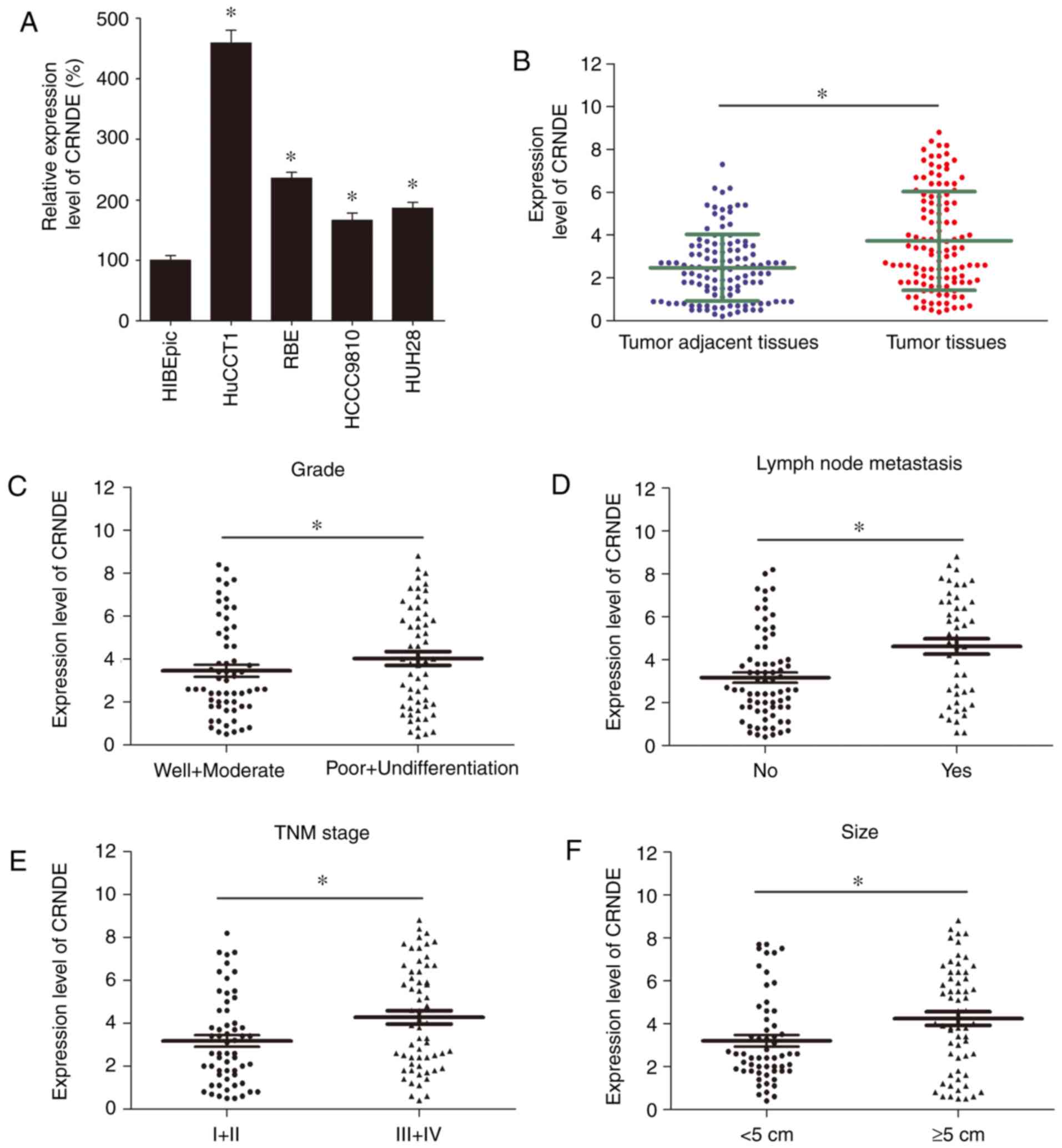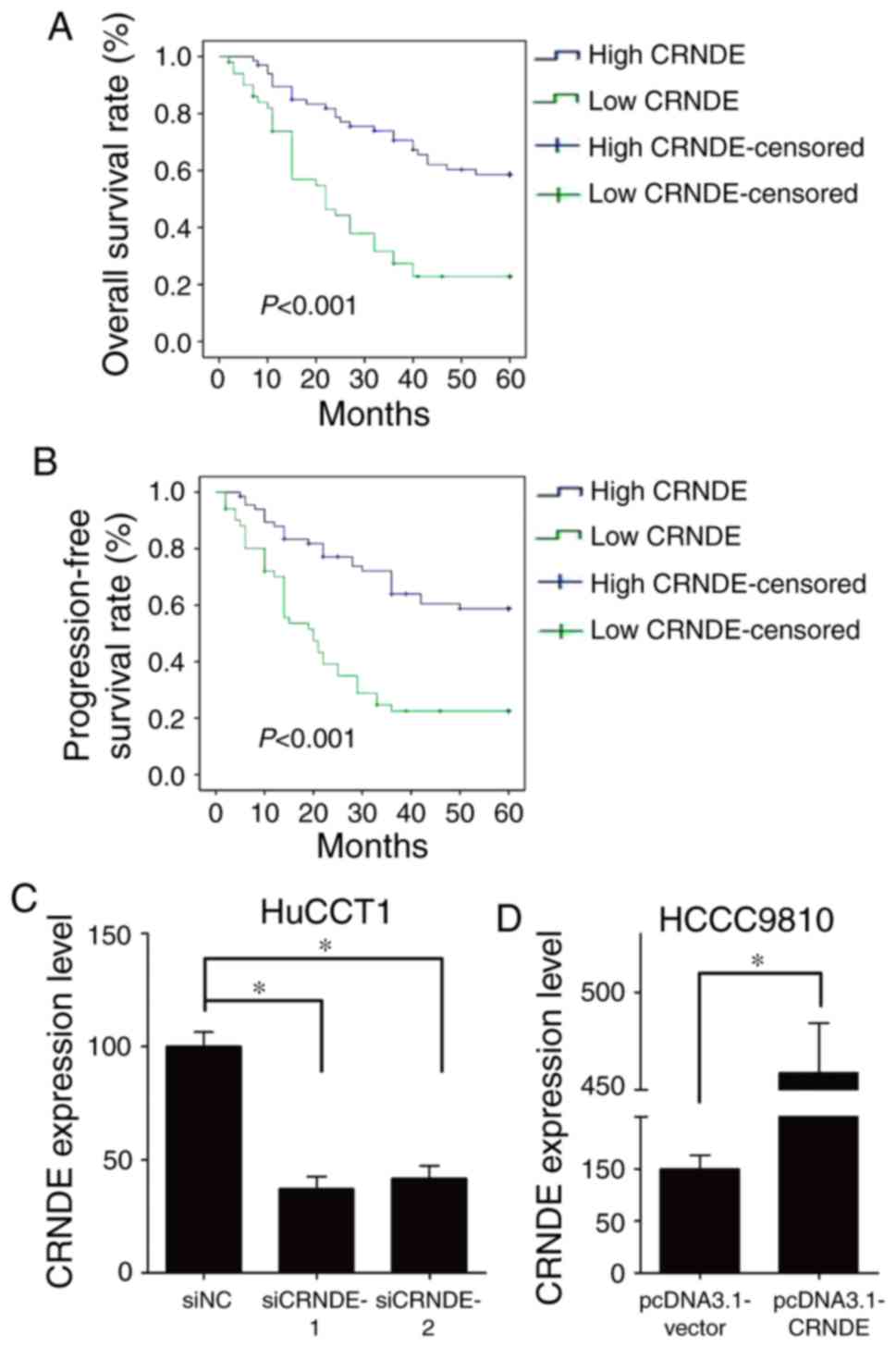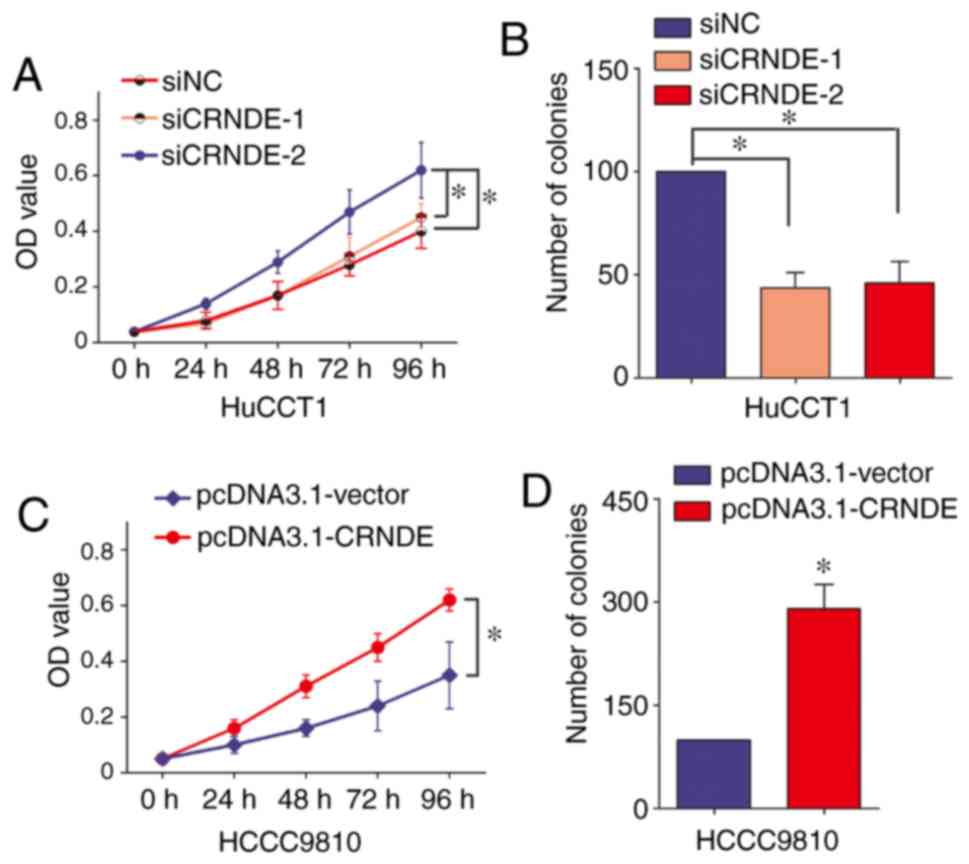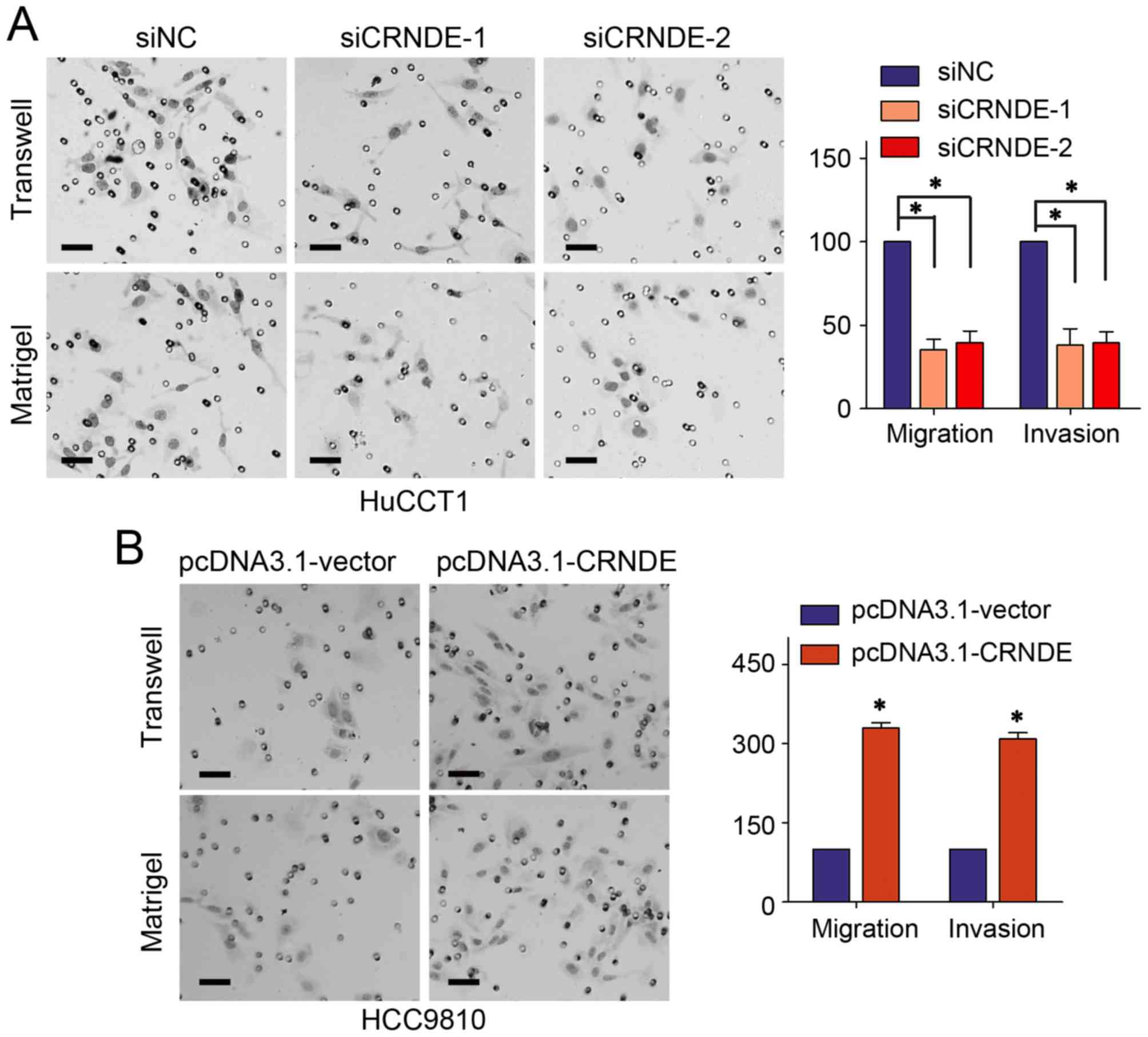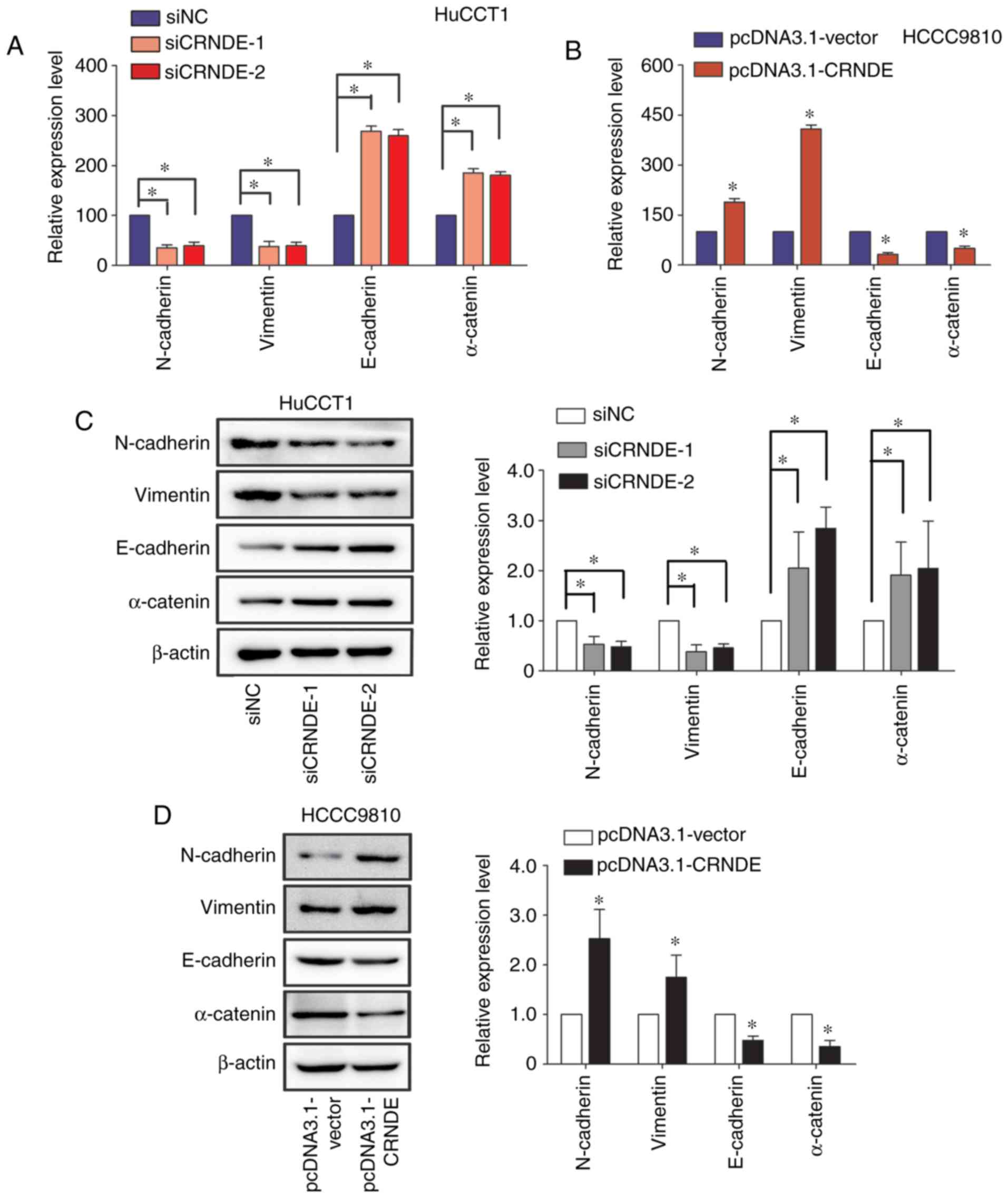Overexpression of long non‑coding RNA CRNDE facilitates epithelial‑mesenchymal transition and correlates with poor prognosis in intrahepatic cholangiocarcinoma
- Authors:
- Published online on: January 17, 2018 https://doi.org/10.3892/ol.2018.7815
- Pages: 4105-4112
-
Copyright: © Xia et al. This is an open access article distributed under the terms of Creative Commons Attribution License.
Abstract
Introduction
Intrahepatic cholangiocarcinoma (IHCC) is the second most common primary hepatic malignancy. The incidence rate and cumulative mortality rate of IHCC have been steadily increasing during past decades (1,2). Despite many advances having been made in the diagnosis and treatment strategies, IHCC is still a great challenge for doctors because of its heterogeneity and aggressiveness. Due to its insidious development process, the vast majority of IHCC patients are diagnosed at an advanced stage, with no access to radical surgical resection. Moreover, the recurrence rate of IHCC patients after surgical resection is high and advanced IHCCs are for the most part unresponsive to systemic chemotherapy and radiotherapy regimens (1). The current overall 5-year survival rate range from 15 to 40%, and patients with unresectable IHCC will typically die within 12–24 months of diagnosis (3). Therefore, the molecular mechanisms of IHCC should be further elucidated, which may shed new light on identifying more effective diagnostic and prognostic markers and therapeutic targets.
Long non-coding RNAs (LncRNAs), defined as different types of RNA polymerase II-transcribed molecules with size greater than 200 nt in length, have been discovered to regulate cellular biology at translational and posttranslational levels, the detailed mechanisms include recruiting transcription factors or chromatin-modifying complexes to their DNA targets, forming heterogeneous nuclear ribonucleoprotein complexes, acting as decoys to sequester RNA-binding proteins and microRNAs, or directly interacting with RNAs and DNAs by base pairing (4). Recent literatures have indicated that lncRNAs are involved in cancer initiation and progression, and numerous lncRNAs have been implicated to be deregulated in cancers and serve as essential regulators in many typical cancer biology pathways (5). Thus, lncRNAs-based therapeutics are considered as novel strategies in cancer treatment in the future (6).
LncRNA colorectal neoplasia differentially expressed (CRNDE), located on the long arm of chromosome 16 (16q12.2) of the human genome, was originally identified as a lncRNA in human colorectal cancer (7). The clinical significance of lncRNA CRNDE has been well studied in multiple tumors, such as colorectal cancer (7–9), renal cell carcinoma (10), and breast cancer (11). However, the potential role of CRNDE in IHCC has not been investigated at present. This study aims to detect the expression level and clinical significance of CRNDE in IHCC, the potential mechanisms of CRNDE exerting its function were also investigated.
Materials and methods
Clinical samples collection
A total of 118 IHCC tissues and paired adjacent normal bile duct tissues were collected from primary IHCC patients who underwent surgery at the Department of General Surgery, the People's Hospital of Binzhou, Binzhou, Shandong Province, China. Informed consents were obtained from all the participants. No anti-cancer treatment was conducted for any patient prior to surgery. Obtained IHCC tissues and paired adjacent normal bile duct tissues were identified by pathological examination. This study protocol was approved by the Ethics Committee of the People's Hospital of Binzhou.
Cell culture and transfection
Normal human intrahepatic biliary epithelial cell (HIBEpic) and four human IHCC cells (HuCCT1, RBE, HCCC9810 and HUH28) were all purchased from the American Type Culture Collection. These cell lines were routinely cultured in DMEM (HIBEpic, HuCCT1, HUH28 and RBE) or RPMI-1640 (HCCC9810), supplemented with 10% fetal bovine serum (FBS) (Sigma, St. Louis, MO, USA), 100 U/ml penicillin sodium, and 100 mg/ml streptomycin sulfate. All cells were cultured in a humidified atmosphere containing 5% CO2 at 37°C.
HuCCT1 cells were transfected with siRNAs targeting CRNDE (siCRNDE-1 and siCRNDE-2) or a scrambled negative control (siNC) (GenePharma, Shanghai, China). HCCC9810 cells were transfected with CRNDE overexpressing vector (pcDNA3.1-CRNDE) or its control vector (pcDNA3.1-Vector) (GenePharma, China). The transfection was conducted with Lipofectamine 2000 (Invitrogen Life Technologies, Carlsbad, CA, USA) according to the manufacturer's protocol.
RNA extraction and RT-qPCR
RNA extraction from cell lines and clinical tissues was conducted with TRIzol reagent (Invitrogen, USA). To determine the mRNA expression level of target genes, SYBR Green fluorescent-based RT-qPCR was performed with an ABI PRISM 7900HT sequence detection system. Relative mRNA expression levels were calculated by the 2−ΔΔCT method. GAPDH was used as internal control. Three independent experiments were conducted and each reaction was performed in triplicate. The primers were as follows: E-cadherin: 5′-CATTGCCACACATACACTCTCTTCT-3′ (forward); 5′-CGGTTACCGTGATCAAAATCTC-3′ (reverse); α-catenin: 5′-GAGCTGTCTACGCAAGTCCC-3′ (forward) and 5′-TTTCGGAGTACATGGGCAAT-3′ (reverse). Vimentin: 5′-GGAACAGCATGTCCAAATCG-3′ (forward); 5′-GCACCTGTCTCCGGTACTCA-3′ (reverse). N-cadherin: 5′-GGTGGAGGAGAAGAAGACCAG-3′ (forward) and 5′-GGCATCAGGCTCCACAGT-3′ (reverse).
Cell proliferation assay
The Cell Counting Kit-8 (CCK-8) (Dojindo Molecular Technologies, Inc., Kumamoto, Japan) and colony formation assay were employed to determine the proliferation of HuCCT1 and HCCC9810 cells in accordance with the manufacturer's instructions. Briefly, HuCCT1 and HCCC9810 cells were seeded into 96-well plates. After transfection, a total of 10 µl CCK-8 reagent was added to each well at designated time points (24, 48, 72, 96 h). Then, cells were incubated for another 3 h followed by measuring the absorbance at 450 nm using an enzyme-linked immunosorbent assay plate reader.
As for the colony formation assay, transfected HuCCT1 and HCCC9810 cells were seeded in 6 cm plates and then subjected to incubator for 7 days in an atmosphere of 5% CO2 at 37°C. Formed colonies were counted with light microscopy. All the experiments were performed in triplicate and repeated at least three times.
Cell migration and invasion assay
Cell migration ability was assessed by Transwell assay using 8 µm-pore-size chambers (BD, San Jose, CA, USA). Cells were seeded in the upper chamber, which was filled with 250 µl serum-free medium. The lower chamber was filled with 600 µl complete medium as chemoattractant. Then, the chambers were subjected to incubation at 37°C for 36 h. Then, cells were fixed with 4% paraformaldehyde and stained with crystal violet. Finally, cells invaded to the lower surface of the filter were counted in five random fields using microscope. To measure the invasion ability of IHCC cells, Matrigel assay was conducted as the Transwell assay, except that each chamber was pre-coated with matrigel (BD, USA) before cell seeding. All the experiments were performed in triplicate and repeated at least three times.
Western blot analysis
Cells were harvested and rinsed with cold phosphate-buffered saline. Then, the total proteins were extracted with RIPA buffer (Thermo Scientific, Rockford, IL, USA) supplemented with protease inhibitors. After protein quantification, an equal amount of protein samples were size fractionated by SDS-PAGE, and separated proteins were electrotransferred onto PVDF membranes (Invitrogen, USA) in transfer buffer. Membranes were then incubated overnight at 4°C with primary antibody, followed by incubation with HRP-conjugated secondary antibody. Antibody-antigen complexes were detected by incubating with ECL detection reagent (Amersham Biosciences, Castle Hill, Australia). ImageJ software was utilized to determine the band intensity.
Statistical analysis
SPSS 17.0 software was utilized for statistical analyses (SPSS, Chicago, IL, USA). Data was presented as mean ± standard deviation (Mean ± SD). Statistically analysis was performed using the Student's t-test for continuous variables and Chi-square test for categorical variables. All tests were two-tailed. By utilizing the mean CRNDE expression level as the cutoff value, all involved patients were divided into the low CRNDE expression group and the high CRNDE expression group. Subquently, the Kaplan-Meier test was conducted to evaluate the survival data and the log-rank test was performed to compare the cumulative survival differencebetween the low CRNDE expression group and the high CRNDE expression group. The statistical significance level was set at 0.05.
Results
LncRNA CRNDE is notably overexpressed in IHCC and significantly correlates with IHCC clinical progression
The expression of lncRNA CRNDE was evaluated in IHCC cell lines and clinical specimens. The result of RT-qPCR assay showed that CRNDE was remarkably up-regulated in IHCC cell lines compared with HIBEpics (Fig. 1A). Further investigation of CRNDE expression in 118 IHCC clinical specimens revealed that tumor tissues displayed much higher expression level relative to tumor adjacent tissues (Fig. 1B). Besides, the expression levels of CRNDE in IHCC patients with poor and undifferentiated grade, lymph node metastasis, tumor-nodes-metastasis (TNM) stage III and stage IV and tumor size no less than 5 cm were much higher than those with well and moderate grade, without lymph node metastasis, TNM stage I and stage II and tumor size less than 5 cm, respectively (Fig. 1C-F).
Furthermore, with mean CRNDE expression level serving as the cutoff value, all IHCC patients were divided into the high CRNDE expression group (n=51) and the low CRNDE expression group (n=67). Statistical analysis between CRNDE expression and IHCC clinicopathological parameters found that high CRNDE expression was obviously correlated with poor and undifferentiated grade (P=0.046), lager tumor size (P=0.001), lymph node metastasis (P=0.001), and advanced TNM stage (P=0.024). (Table I) These findings suggested that CRNDE overexpression could promote the clinical progression of IHCC.
High CRNDE expression is an independent risk factor of IHCC poor prognosis
For further verifying the clinical significance of high CRNDE expression in IHCC, the prognostic value of CRNDE was evaluated. Intriguingly, high CRNDE expression was discovered to correlate with poorer overall survival (OS) rate (P<0.001), (Fig. 2A) and shorter progression-free survival (PFS) period (P<0.001) (Fig. 2B).
In addition, the risk factors of IHCC OS and PFS were statistically analyzed by univariate COX regression analysis and multivariate COX regression analysis. Univariate analysis revealed 5 risk factors for worse OS (Table II) and 6 risk factors for poor PFS (Table III) in IHCC patients, respectively. By further analyzing these factors with multivariate analysis, lymphovascular invasion (HR=0.530, 95% CI=0.313–1.224, P=0.018), advanced TNM stage (HR=3.695, 95% CI=1.357–10.060, P=0.011) and high CRNDE expression (HR=1.309, 95% CI=1.160–1.478, P<0.001) were highlighted as independent risk factors of poor OS in IHCC. (Table II) Interestingly, these three factors, lymphovascular invasion (HR=0.432, 95% CI=0.255–0.734, P=0.002), advanced TNM stage (HR=2.484, 95% CI=1.104–5.586, P=0.028) and high CRNDE expression (HR=1.305, 95% CI=1.168–1.459, P<0.001), were also identified as independent risk factors of shorter PFS period. (Table III).
Table II.Univariate and multivariate analysis of clinicopathologic features for overall survival of IHCC patients. |
Table III.Univariate and multivariate analysis of clinicopathologic features for progrerssion-free survival of IHCC patients. |
Overexpression of lncRNA CRNDE could promote the proliferation of IHCC cells
To detect the functional role of CRNDE in IHCC cells, the expression of CRNDE was silenced with siRNAs in HuCCT1 cells (Fig. 2C), and ectopic overexpressed in HCCC9810 cells (Fig. 2D), respectively. Then, the effect of CRNDE on IHCC proliferation was evaluated with CCK-8 assay and colony formation assay. CRNDE silencing obviously inhibited the proliferation of HuCCT1 cells on CCK-8 assay and colony formation assay (Fig. 3A and 3B). Consistently, the proliferation ability of HCCC9810 cells was notably increased with CRNDE ectopic overexpression (Fig. 3C and D). It was concluded that CRNDE could promote the proliferation of IHCC cells.
LncRNA CRNDE promotes IHCC metastasis by regulating EMT
Metastasis is the final stage of caner-caused death, the detailed mechanisms of tumor metastasis have been investigated for several decades but remain obscure at present. The present study confirmed CRNDE interference in HuCCT1 cells could repress the migration and invasion abilities on Transwell assay and Matrigel assay, respectively (Fig. 4A). While the motility of HCCC9810 cells was obviously increased with CRNDE up-regulation (Fig. 4B).
Epithelial-mesenchymal transition (EMT) is an essential process in the initiation and progression of cancer metastasis (12,13). This study investigated the role of CRNDE on IHCC EMT by evaluating the expression of epithelial markers (E-cadherin and α-catenin) and mesenchymal markers (N-cadherin and Vimentin) (14). As expected, the mRNAs levels of mesenchymal markers were notably reduced with CRNDE knock-down in HuCCT1 cells, while the mRNAs levels of epithelial markers were greatly improved with CRNDE silencing (Fig. 5A). Consistently, CRNDE overexpression in HCCC9810 cells increased the mRNAs levels of mesenchymal markers, accompanied with down-regulation of epithelial markers (Fig. 5B). The results of the western blot assay further confirmed the findings of the RT-qPCR assay (Fig. 5C and D). Together, CRNDE could promote the metastasis of IHCC cells by facilitating EMT.
Discussion
Accumulating evidence has revealed that lncRNAs are essential participants in cancer biology. LncRNAs are involved in almost every aspect of cellular biology by acting as transcriptional modulators, splicing regulators, posttranscriptional processors, enhancers, molecular decoys for miRNAs, chromatin remodelers, or as guides for protein-protein, protein-DNA and protein-RNA interactions (15,16). Recent literatures have indicated that lncRNAs are often expressed in a disease-, tissue- or developmental-specific manner, which makes a foundation for utilizing lncRNAs as biomarkers and therapeutic targets in different diseases. Moreover, the number of lncRNAs has recently been greatly expanded to triple the number of protein-coding genes (5). Therefore, lncRNAs are likely to serve as the basis for clinical diagnosis and treatment in oncology.
The present study discovered that lncRNA CRNDE was up-regulated in IHCC cells and tissues, and high CRNDE expression significantly promoted clinical progression of IHCC, including poorer differentiation, larger tumor size, lymph node metastasis, and advanced TNM stage. Further investigations found CRNDE up-regulation predicted poorer OS and earlier recurrence of IHCC patients. Moreover, CRNDE was revealed to be an independent risk factor of poor OS and PFS in IHCC. The results of in vivo studies verified that CRNDE could increase the proliferation ability of IHCC cells on CCK-8 assay and colony formation assay. By detecting the mRNA levels and protein levels of EMT markers, we confirmed CRNDE could facilitate the EMT of IHCC cells and thus promote the metastasis of IHCC cells, which was also confirmed by Transwell assay and Matrigel assay. All these results suggested that CRNDE could promote the progression of IHCC and may serve as a promising prognostic marker and therapeutic target of IHCC patients.
Increased CRNDE expression was first discovered by Graham and his colleagues (7) in the early stage of colorectal neoplasia, and was regarded as a promising tissue and plasma biomarker in colorectal cancer early detection. Since then, the functional roles and mechanisms of CRNDE in cancer development and progression have been gradually exhibited. It has been demonstrated that CRNDE was up-regulated in various solid tumors, including hepatocellular carcinoma, renal cancer, adrenocortical carcinoma, pancreatic cancer, prostate cancer, ovarian cancer, and leukemias (17). CRNDE is a multifunctional lncRNA and functions through different splice forms, which could provide specific functional scaffolds for regulatory complexes, such as the polycomb repressive complex 2 (PRC2) and CoREST chromatin-modifying complexes (18). Besides, CRNDE exhibited a very time- and tissue-specific pattern of expression. Recent literatures have discovered some other signaling pathways through which CRNDE exerts its functions. Zheng et al (19) demonstrated that CRNDE played an oncogenic role in human glioma stem cells through negatively regulating miR-186 expression. Besides, CRNDE was discovered to recruit the Deleted in Malignant Brain Tumors 1 (DMBT1) and Baculoviral IAP repeat Containing 1 (c-IAP1) through acting as a scaffold, which could accelerate gallbladder cancer development by promoting the PI3K-AKT pathway (20). In breast cancer, CRNDE was revealed to promote tumor growth through acting as a molecular sponge of miR-136, and thus hyperactivating the Wnt/β-catenin signaling pathway (11). Therefore, various signaling pathways may underlie the functions and mechanisms of CRNDE in different cancers. The detailed mechanisms of CRNDE exerting its functions deserve further investigations.
In conclusion, the present study confirmed that CRNDE was up-regulated in IHCC cells and tissues. Statistical analyses found CRNDE expression was positively correlated with IHCC clinical progression, poor OS and PFS. Furthermore, univariate and multivariate COX regression analyses discovered that CRNDE overexpression was an independent risk factor of IHCC poor OS and PFS. The function of CRNDE was also confirmed in vitro assays by detecting its role in affecting the proliferation and metastasis of IHCC cells. Mechanistically, EMT was demonstrated to be accelerated with CRNDE up-regulation, which may be the underlying mechanism of CRNDE promoting IHCC metastasis. These findings indicated that CRNDE may be an essential prognostic marker and therapeutic target in IHCC.
References
|
Sirica AE, Dumur CI, Campbell DJ, Almenara JA, Ogunwobi OO and Dewitt JL: Intrahepatic cholangiocarcinoma progression: Prognostic factors and basic mechanisms. Clin Gastroenterol Hepatol. 7 11 Suppl:S68–S78. 2009. View Article : Google Scholar : PubMed/NCBI | |
|
Razumilava N and Gores GJ: Cholangiocarcinoma. Lancet. 383:2168–2179. 2014. View Article : Google Scholar : PubMed/NCBI | |
|
Aljiffry M, Abdulelah A, Walsh M, Peltekian K, Alwayn I and Molinari M: Evidence-based approach to cholangiocarcinoma: A systematic review of the current literature. J Am Coll Surg. 208:134–147. 2009. View Article : Google Scholar : PubMed/NCBI | |
|
Chen LL: Linking long noncoding RNA localization and function. Trends Biochem Sci. 41:761–772. 2016. View Article : Google Scholar : PubMed/NCBI | |
|
Evans JR, Feng FY and Chinnaiyan AM: The bright side of dark matter: lncRNAs in cancer. J Clin Invest. 126:2775–2782. 2016. View Article : Google Scholar : PubMed/NCBI | |
|
Adams BD, Parsons C, Walker L, Zhang WC and Slack FJ: Targeting noncoding RNAs in disease. J Clin Invest. 127:761–771. 2017. View Article : Google Scholar : PubMed/NCBI | |
|
Graham LD, Pedersen SK, Brown GS, Ho T, Kassir Z, Moynihan AT, Vizgoft EK, Dunne R, Pimlott L, Young GP, et al: Colorectal neoplasia differentially expressed (CRNDE), a novel gene with elevated expression in colorectal adenomas and adenocarcinomas. Genes Cancer. 2:829–840. 2011. View Article : Google Scholar : PubMed/NCBI | |
|
Gao H, Song X, Kang T, Yan B, Feng L, Gao L, Ai L, Liu X, Yu J and Li H: Long noncoding RNA CRNDE functions as a competing endogenous RNA to promote metastasis and oxaliplatin resistance by sponging miR-136 in colorectal cancer. Onco Targets Ther. 10:205–216. 2017. View Article : Google Scholar : PubMed/NCBI | |
|
Yu B, Ye X, Du Q, Zhu B, Zhai Q and Li XX: The long non-coding RNA CRNDE promotes colorectal carcinoma progression by competitively binding miR-217 with TCF7L2 and enhancing the Wnt/β-catenin signaling pathway. Cell Physiol Biochem. 41:2489–2502. 2017. View Article : Google Scholar : PubMed/NCBI | |
|
Shao K, Shi T, Yang Y, Wang X, Xu D and Zhou P: Highly expressed lncRNA CRNDE promotes cell proliferation through Wnt/β-catenin signaling in renal cell carcinoma. Tumour Biol. Oct 6–2016.(Epub ahead of print). View Article : Google Scholar | |
|
Huan J, Xing L, Lin Q, Xui H and Qin X: Long noncoding RNA CRNDE activates Wnt/β-catenin signaling pathway through acting as a molecular sponge of microRNA-136 in human breast cancer. Am J Transl Res. 9:1977–1989. 2017.PubMed/NCBI | |
|
Tsai JH and Yang J: Epithelial-mesenchymal plasticity in carcinoma metastasis. Genes Dev. 27:2192–2206. 2013. View Article : Google Scholar : PubMed/NCBI | |
|
De Craene B and Berx G: Regulatory networks defining EMT during cancer initiation and progression. Nat Rev Cancer. 13:97–110. 2013. View Article : Google Scholar : PubMed/NCBI | |
|
Zeisberg M and Neilson EG: Biomarkers for epithelial-mesenchymal transitions. J Clin Invest. 119:1429–1437. 2009. View Article : Google Scholar : PubMed/NCBI | |
|
Bartonicek N, Maag JL and Dinger ME: Long noncoding RNAs in cancer: Mechanisms of action and technological advancements. Mol Cancer. 15:432016. View Article : Google Scholar : PubMed/NCBI | |
|
Chandra Gupta S and Nandan Tripathi Y: Potential of long non-coding RNAs in cancer patients: From biomarkers to therapeutic targets. Int J Cancer. 140:1955–1967. 2017. View Article : Google Scholar : PubMed/NCBI | |
|
Ellis BC, Molloy PL and Graham LD: CRNDE: A long non-coding RNA involved in canceR, neurobiology, and DEvelopment. Front Genet. 3:2702012. View Article : Google Scholar : PubMed/NCBI | |
|
Khalil AM, Guttman M, Huarte M, Garber M, Raj A, Rivea Morales D, Thomas K, Presser A, Bernstein BE, van Oudenaarden A, et al: Many human large intergenic noncoding RNAs associate with chromatin-modifying complexes and affect gene expression. Proc Natl Acad Sci USA. 106:pp. 11667–11672. 2009; View Article : Google Scholar : PubMed/NCBI | |
|
Zheng J, Li XD, Wang P, Liu XB, Xue YX, Hu Y, Li Z, Li ZQ, Wang ZH and Liu YH: CRNDE affects the malignant biological characteristics of human glioma stem cells by negatively regulating miR-186. Oncotarget. 6:25339–25355. 2015. View Article : Google Scholar : PubMed/NCBI | |
|
Shen S, Liu H, Wang Y, Wang J, Ni X, Ai Z, Pan H, Liu H and Shao Y: Long non-coding RNA CRNDE promotes gallbladder carcinoma carcinogenesis and as a scaffold of DMBT1 and C-IAP1 complexes to activating PI3K-AKT pathway. Oncotarget. 7:72833–72844. 2016. View Article : Google Scholar : PubMed/NCBI |



